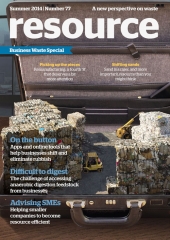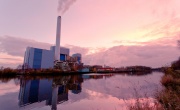It's all material
St David’s Dewi Sant shopping centre is finding out for itself how useful a MRF can be. Annie Reece investigates
The retail industry often hits headlines for being unsustainable, but one shopping centre, St David’s Dewi Sant in Cardiff, is turning this image on its head by sending zero waste to landfill. Last year, the centre won a Green Apple award for its commitment to waste management and sustainability, and this year, it received Bronze in the Zero Waste Awards.
Its success has come through a two-pronged attack, Centre Director Steven Madeley tells me, by recycling as much waste as possible and sending the rest to energy recovery. He explains that the centre recently tripled in size to 1.4 million square feet, noting: “Before we enlarged, we only separated out cardboard, then we moved on to separate out clear plastics. As the new section had lots of restaurants, we started to separately recycle glass bottles, and, subsequently, we introduced food waste recycling. By doing this, we’d improved our recycling to 66 per cent in 2012, but we were looking for a step-change to improve still further.”
Working with Technical Services Manager Brian Vaughan, Madeley undertook a review evaluating the waste produced by the site’s 180 retail units and 36 million visitors a year. “The retail units don’t have that much storage space, so we couldn’t expect the retailers to sort their waste into, say, 10 different bins, because they’d be really tight on space. So, Brian suggested we think about setting up a materials recovery facility [MRF] on site to sort the remaining waste.”
By selecting waste bins at random to audit, Vaughan found that the majority of black bag waste was recyclable (mostly plastic and paper) and could be sold on. “That gave us the confidence to make quite a big investment – the MRF kit cost around £120,000, and that’s excluding wage costs”, Madeley tells me, adding that the business saw a return on its investment within 11 months.
Built in the underground service yard, the MRF now accepts around 700 tonnes of material from the retail units and public bins a year, which a team of eight staff from contractor OCS Group sorts into different streams: soft plastics; hard plastics; paper; aluminium; textiles; and some glass and cardboard that isn’t collected separately. (Madeley tells me that the management team has also tried its hand at sorting the waste: “Some of us did better than others – it’s challenging, but it makes you realise what a great job those working down there do. Next time, I’ll remember not to wear a white shirt with nice pristine sleeves, though!”)
 This article was taken from Issue 77
This article was taken from Issue 77The MRF is helping the shopping centre divert around 1,700 tonnes of waste from landfill per year; just under 80 per cent is recycled, generating around £33,000 in material revenue. All residual waste (about 580 tonnes) goes to a refuse-derived fuel plant, but Madeley hints that if the nearby Prosiect Gwyrdd incinerator gets the go-ahead, the centre could send its residual waste there and recoup heat in return.
He concludes that the MRF continues to be the most cost-efficient means of sorting waste: “The biggest cost to us by far is the cost of the staff to sort the waste – but not only do we save by not paying for landfill, we also get money back for the material and by having fewer compactors on site. I would say that for shopping centres of this size – and there are a number of them across the UK – having an in-house MRF is definitely worthwhile, both economically and from an environmental perspective.”
He adds that the management team is now looking to boost its recycling rates further by introducing a clean paper stream “because you can get a better price for white-based paper than you can for mixed or coloured paper”.
And, aside from waste, the centre also has two bat boxes, as well as a green roof that improves the building’s energy efficiency and provides pollen to the local bees – some 10,000 of which now reside in the shopping centre’s six hives. Here’s hoping the centre makes honey from all its efforts soon… 








